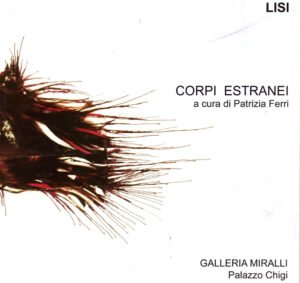Lisi is a ‘threshold’ artist, a poet of the radical void that cultivates cyclic and imponderable obsessions that in sudden and rhythmic waves and romantic undertows alleviate from the unbearable weight of existence. His signic search, in its variables in time, surpasses the identification between art and life and the distinction between conscious and unconscious: it does not represent, it does not express, it simply manifests a continuity between itself and the world, expressed in terms of difference between magnitudes and quality of tensions, in the synergy between gesture and sign of informal derivation, relating the dynamics of the physiological microcosm and the cosmic macro space.
The beginning of each cycle of works is not planned, and it expresses a sort of regeneration, a true aesthetical and existential rebirth according to an idea of art that continues to question its intrinsic reasons and its function, beyond the assertive logics of meaning.
In the “Alien Bodies”, the latest cycle (time wise) unseen so far, the sign is a sensitive, irritable string, as a nerve ending that creates tangles, vacuum energetic concentrates, imploded phenomenologies, energy blackouts of a highly concentrated spatiality, concretions, alien bubbles, the quintessence of worlds where mysterious events take place, kept inside the page margins that, like so many daily short stories, tell all together about a life that was let go moment by moment, as in the Oriental meditative methods, for which Lisi manifests yet again an absolutely natural aptitude. The sign is a philosophic and physiologic conductor, as an author’s appendix, but also as something other than himself, where crossbreeding with the image produces symptoms of alarm and arrhythmia in an occult, mysterious tension.
The “Alien Bodies” are tattoos that sensitise the artist’s being in his contact with the world, a contact that lightens and becomes bearable, manifesting without revealing the deep sense of life as a dynamic cycle in its intrinsic reality of expansion and regression, evolution and involution, development and stagnation, systoles and diastoles, following an attitude that substantially expresses the capability of letting art get under one’s own skin.
(translated by Helen Pringle)
(text for the exhibition “Corpi estranei”, Galleria Miralli, Palazzo Chigi, Viterbo – 24 May-7 June 2009)
